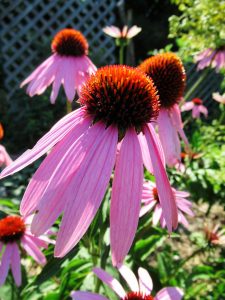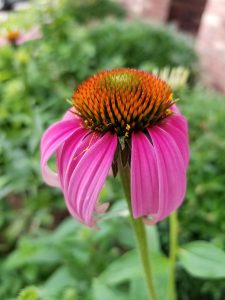 |  |
| Leaves are wider, flower petals are longer and seed head more conical | Leaves are narrow and lanceolate, pointing upward |
| Name Latin: Echinacea pupurea Other Names: Purple Coneflower, Eastern Purple Coneflower, echinacea, snakeroot, Kansas snakeroot, scurvy root, Indian head, comb flower, black susans, and hedge hog, Rudbeckia purpurea | Latin Name: Echinacea angustifolia Other Names: Narrow-leaved Purple Coneflower, Black sampson Echinacea, Brauneria angustifolia, snake root, scurvy root, comb flower, Rudbeckia purpurea |
| Links to more information minnesota wildflowers info Eastern Purple Coneflower | Links to more information Minnesota wildflowers info Narrow leaved Purple Coneflower |
| Life Cycle: Perennial Light Requirements: Full Sun, Half Sun / Half Shade Flower Color: Purple Bloom Time: Summer/early fall Mature Height: 24-48" tall Ideal US Region: NE, SE, Midwest, West, SW, Pacific NW Zones: 3-8 Native To: North American plains Soil Type: Sandy, Loamy, Clay, Drought/Dry Soil Soil Moisture: Dry, Average, Well Draining Advantages: Easy To Grow, Attracts Butterflies, Birds & Bees, Deer Resistant, Native, Low Maintenance, Fragrant, Good For Cut Flowers, Good For Containers, Great For Mass Plantings, Winter Interest | Life Cycle: Perennial Light Requirements: Full Sun Flower Color: Purple/Pink Bloom Time: June, July Mature Height: 2 feet Zones: 4-9 Native to: central Canada and the central United States from Saskatchewan and Manitoba in the north to Arizona, New Mexico, Texas, and Louisiana in the south. Soil Type: average, dry to medium, well-drained soils, dry prairies and rocky barrens Soil Moisture: Medium-Dry, Dry Advantages: Attracts Butterflies, Bees, Birds and many pollinators, Deer Resistant, Native, Low Maintenance, Good for Cut Flowers, drought tolerant. The threatened Ottoe Skipper's life cycle depends greatly on Echinacea angustifolia, and drier prairie grasses such as Little Bluestem, Side-oats Grama and Prairie Dropseed. |
| Ethnobotanical uses: Per the USDA.gov Plant Guides – “was and still is a widely used medicinalplant of the Plains Indians. It was used as a painkiller and for a variety of ailments, including toothache,coughs, colds, sore throats, and snake bite (Kindscher1992). The Choctaw use purple coneflower as acough medicine and gastro-intestinal aid (Moerman 1986). The Delaware used an infusion of coneflowerroot for gonorrhea and found it to be highly effective.” Source: Source | Ethnobotanical uses: Rattlesnake bites and other venomous bites, stings and poisonous conditions, eye wash, rabies (hydrophobia), Lakota Indians used the root and green fruits as a painkiller for tooth aches, bowel pains, stomach ache and tonsillitis. Root used as cough medicine, for sore throat and colds, sore mouth and gums. The root was chewed to stimulate saliva, which allayed thirst. Tea was consumed for rheumatism, mumps, arthritis, and measles. Roots were mixed with Blazing Star and the tea was taken for smallpox. The roots were used for boils. A tea prepared from the root was used for colic. Small pieces of root were chewed for a stimulant. |
| Historical uses: Used extensively as a folk remedy. Purple coneflower root was used by early settlers in nearly every kind of illness. If a cow or a horse did not eat well, Echinacea was administered in its feed. Influenza Herpes Immuno-stimulant Anti-inflammatory Urological disorders Gynecological disorders Dermatological disorders Common cold Infections Respiratory tract infections Cough Bronchitis Wounds Echinacea was listed in the US National Formulary from 1916-1950. However, use of echinacea fell out of favor in the United States with the discovery of antibiotics. | Historical uses: Typhoid, malaria, fever. Used to relieve pain, swelling and inflammation internally and externally. Cure for Diptheria. Cure for bug bites from Bees to snakes. Cure for rabies and hydrophobia. Was a therapeutic favorite for thousands of American physicians in the late 19th & early 20th centuries. Immunostimulant. |
| Medicinal Preparations and Dosage: • Tincture of dried root, leaves or flowers: 1:5 (50%A:50%W) Dosage: Infant (10 weeks – 3 years) 2-5 drops diluted in liquid 3-5 times/day. Children (4yr – 10 yr) 5-15 drops diluted in liquid 3-5 times/day. Adult 30-60 drops (1-2 droppers full) diluted in liquid 3-5 times/day. Senior 30 drops diluted in liquid 3-5 times/day. • Tincture of fresh root, leaves, or flowers: 1:2 (75%A:25W) Dosage: same as for tincture of dried roots, leaves, flowers. • Tincture of ground/bruised seed: 1:5 (75%A:25%W) Dosage: same as for tincture of dried roots, leaves, flowers. • Glycerite of fresh root, leaves or flowers: 1:2 (100Gly) Dosage: Double that of dosage for dried root, leaves or flowers. • Water extracts: Tea of dried leaves and flowers: Dosage: 1-2 gram chopped or ground dried herb per cup – cover & steep 5-15 min. Decoction of dried root: Dosage: 30 g dried herb per quart water brought to boil, simmer 15 min. (Optional - soak in cold water overnight first) • Native American Usage: took 1-2 g of fresh or recently dried root held in the mouth and slowly chewed | Same as for Echinacea purpurea Alternatively: ½ to 1 fluid drachm 3-4 times/day (1 fluid drachm = 0.125 fluid ounce) Best results occur when the tincture of the ground root is made with a menstruum of 4 volumes alcohol to 1 volume water. Essential oil of the root is also used |
Echinacea spp. was listed in the United States Pharmacopeia and National Formulary (USP-NF) – an official publication that gives the composition, description, method of preparation, and dosage for drugs – until the late 1940s (Flannery 2000; Foster 1985).
Flannery, Michael A. 2000 . From Rudbeckia to Echinacea – The Emergence of the Purple Cornflower in Modern Therapeutics. In HerbalGram The Journal of the American Botanical Council, Issue: 51 pp.28-33
Foster, Steven. ed. 1985 . Echinacea exalted! The Botany, Culture, History and Medicinal Uses of the Purple Cornflowers. Ozark Beneficial Plant project. New Life Farm Inc: Brixey, Missouri.
Links to documents
Echinacea, A Miracle Herb against Aging and Cancer
Echinacea: Ethnobotany of Purple Conflower
Echinacea purpurea: Pharmacology, phytochemistry and analysis methods

